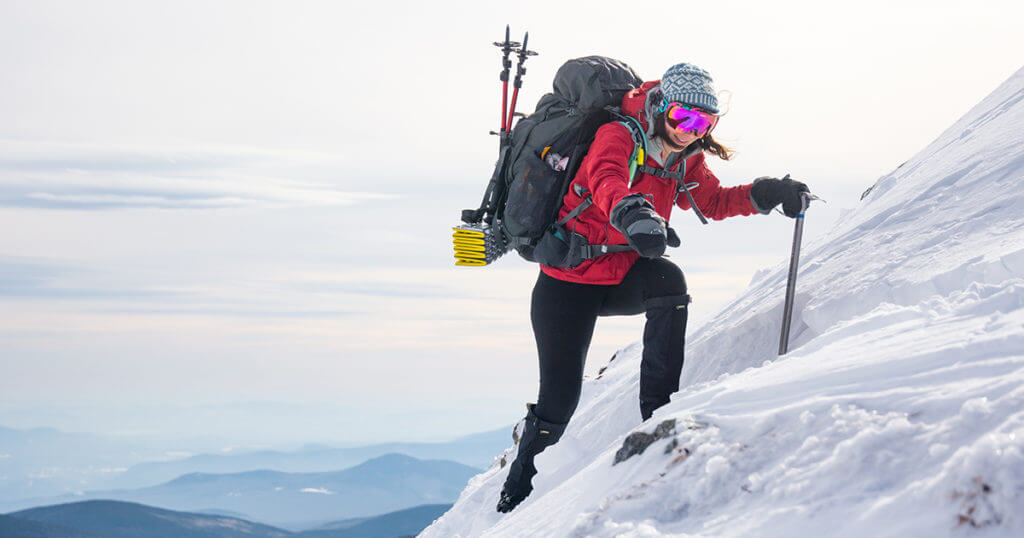
Packing the right gear is essential for having a safe and enjoyable winter hike.
Hiking in the winter demands more. More preparedness and more planning. More outdoor experience and ability, and—perhaps most easily overlooked—more time. The cold months require better decision-making and a more cautious mindset. The same trail you hiked in summer six months ago is a different world now. Just as a wind chill intensifies the cold, winter has a way of magnifying mistakes.
Knowing what you’re getting into, checking the weather, making a friend aware of your plans, wearing and carrying the appropriate gear for the time of year and terrain: these are the basics of hiking any time of year. But they’re never more important than in winter.
If you are new to winter hiking and don’t know how to start, consider venturing into the backcountry with an AMC Wilderness Guide or participating in a local hike led by an AMC Chapter. Using guidebooks to find hikes in your area or improve your outdoor skills can also be helpful.
The following gear list is intended as a resource for winter day hike preparation. Not every person will need to bring every item. When you head into the backcountry, you are responsible for assessing the terrain, current conditions, and what items you should have in your pack to survive if you encounter a mishap or sustain an injury. If you are staying at the AMC Highland Center in New Hampshire, our staff can help equip you for a day hike using gear from our L.L.Bean Gear Room.
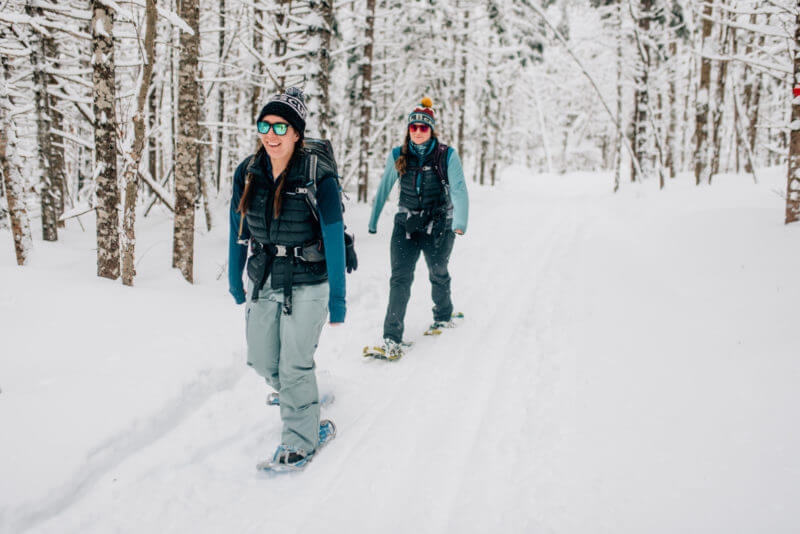
Snowshoers enjoy the trails around AMC’s Gorman Chairback Lodge and Cabins in the Maine Woods.
Feet
One of the best ways to stay safe on a backcountry winter outing is to keep your feet warm and dry. Strong, dry feet are vital not only to keep moving on a backcountry hike or ski, but to rescue yourself should an emergency arise.
Boots: Waterproof and insulated to a temperature rating of 0 degrees for lower-elevation backcountry hiking or snowshoeing. For more advanced mountaineering at higher elevations, pick boots that are insulated to temperature rating of 20 to 40 degrees below zero. If you are hiking in icy conditions in higher elevation areas, your boots may need to be compatible with crampons—whose long spikes give winter hikers significantly more traction and stability.
Hiking socks: Made from wool or synthetic material. These fabrics will keep your feet warm even if they get wet. Bringing an extra pair is recommended.
Gaiters: A waterproof garment that protects against rain and snow. It is worn over your hiking boot and stretches up your lower pant leg to knee height.
Snowshoes: Footwear for walking on snow. You should bring snowshoes that are designed for flat to rolling terrain. Be sure to make adjustments and test them out at home before using them on a hike. If you are planning to hike in higher elevation areas, you’ll need snowshoes that are designed for steep terrain. (Read our snowshoeing guide for beginners.)
Microspikes: Chains and small spikes that are worn over your hiking boots for additional traction on relatively flat to moderately steep terrain. Make sure that your spikes fit over your hiking boots before hitting the trail.
Tops
Dressing for winter is all about layering. You may not wear every clothing item in your pack at a given time, but having extra layers to change into is essential if you get wet or when temperatures drop. Make sure you don’t wear any clothes made out of cotton. This fabric absorbs moisture easily and, when wet, will rapidly draw warmth away from your body. A lack of proper insulation can cause disorientation, hypothermia or, in extreme cases, death.
Base layer: Long- or short-sleeve shirt made out of synthetic/wicking material.
Mid-layer: Long- or short-sleeve shirt made out of wool or wool/synthetic blended material. If the weather is going to be cold, it’s a good idea to bring an extra mid-layer with you.
Outer-layer: Lightweight fleece.
Insulating layer: Down or fiber parka. If possible, having a parka with a hood is ideal because it can be used to insulate your head and neck as well.
Shell: Windproof/waterproof breathable layer that is large enough to fit over multiple layers you may already be wearing.
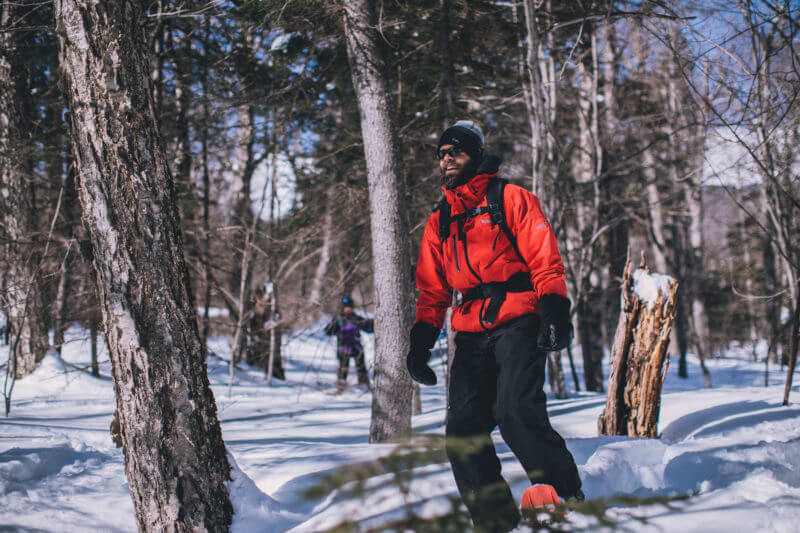
Well-outfitted AMC Family Adventure participants enjoy snowshoeing in New Hampshire’s White Mountain National Forest.
Bottoms
Bottom layers, like top layers, should be made out of non-cotton material. As always, pack extra layers for your hike in the event that things don’t go to plan, such as experiencing an unexpected cold front.
Base layer: Leggings or long underwear made from wool or synthetic material. Depending on the temperature and weather conditions, you can choose to either begin the hike by wearing or packing this layer.
Mid-layer: Leggings or pants made from light-weight fleece or warm synthetic material.
Shell: Pants that are windproof/waterproof and breathable. Having a shell with a full side zipper is highly recommended.
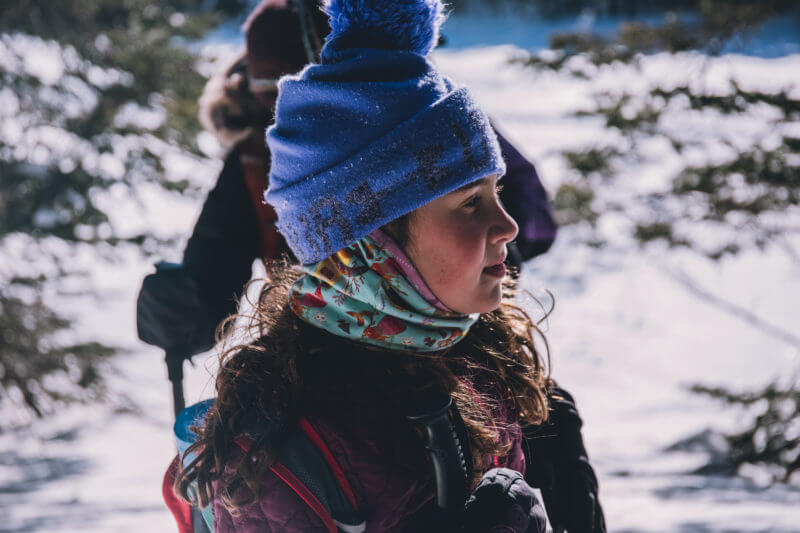
Combine a hat with a neck gaiter for optimal warmth.
Head and Hands
As with the other layers, avoid clothing that is made out of cotton or other non-insulating materials, such as leather.
Hat: Completely covers your head and ears and is made out of fleece or wool. Bringing an extra hat is recommended.
Neck Gaiter: Worn around the neck for warmth and made from synthetic or fleece. This is also known as a neck warmer or buff.
Gloves: Made from fleece, wool, or synthetic material, not leather. Bringing an extra pair of gloves is recommended.
Mittens: Worn over your gloves as an external wind/waterproof layer for your hands. Bringing an extra pair of mittens is recommended.
Balaclava and/or face mask: Worn over your head and/or face and made from synthetic material or fleece.
Sunglasses: Protects your eyes from harmful UV rays that reflect off of snow and ice in the winter.
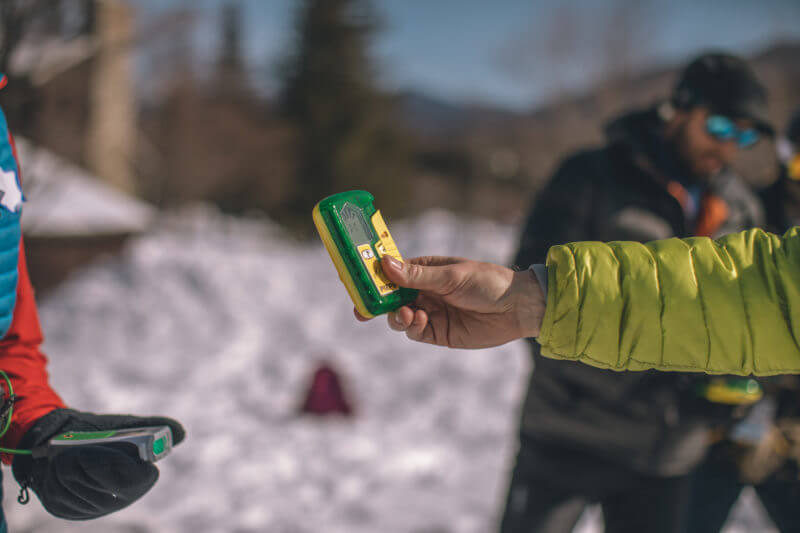
Avalanche training participants at AMC’s Joe Dodge Lodge check their avalanche beacons.
Above Treeline Gear
Additional items may be required for extreme conditions, such as extended above-treeline travel or travel in avalanche terrain. Some of this equipment requires specialized instruction and knowledge, practice, and an ability to take yourself and/or your group into harsh, often unforgiving conditions. Without the proper training, certain items, such as an ice axe or avalanche beacon, are useless if you don’t know how to use them. If you are interested in learning more, consider attending one of the workshops or courses offered by AMC and its local Chapters.
Insulating layer: “Puffy pants” made from down or fiber parka.
Crampons: Traction devices used to travel on snow and ice in steeper terrain. The number of points, or spikes, on the bottom of crampons generally increase when needed for more technical terrain. For example, most snow walking and general mountaineering crampons will have 8 to ten points, whereas crampons used for ice climbing will have 14 points or more. Make sure to fit your crampons to your boots before going on a hike.
Avalanche beacon: An electric device worn on the body that both emits and receives radio signals. If someone is buried in an avalanche and their beacon is turned to the receive setting, other members of their party can use their own beacons to locate the victim under the snow. Taking an avalanche safety course is highly recommended if you plan to recreate in areas with avalanche risks.
Extensive first aid kit: A medical kit that treats minor injuries, such as blisters or cuts, as well as more serious ones, like a broken bone. We highly recommend taking a Wilderness First Aid Course so that you are properly prepared to deal with injuries in the backcountry.
Tinted Goggles: Ski goggles or glacier glasses that will help protect your eyes from sunlight reflecting off ice and snow. Overexposure to UV rays in winter can cause a painful conditions called snow blindness.
Ice axe: A 65 to 75 cm long mountaineering axe with a strap. Shorter technical ice climbing axes usually do not work as well if you are trying to self arrest, which is stopping yourself from sliding down an icy/snowy incline. Taking a mountaineering or outdoor skills course to learn the proper technique for self arresting is highly recommended.
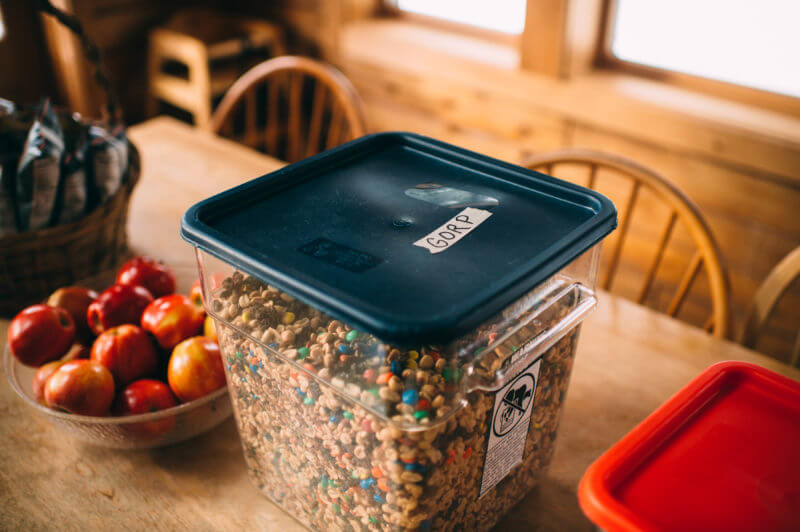
Fueling your body with proper nutrition is crucial on winter adventures, when you’ll burn more calories than you would in other seasons.
Food and Water
When hiking in cold weather, your body requires much more fuel to keep moving and stay warm. For a typical winter day hike, the energy expended will be 2,000 to 3,000 more calories over what you normally eat. Hiking in these conditions is not the time to diet. Make sure you are eating and drinking water frequently in order to avoid dehydration and depleted energy levels.
Water: At least 2 liters. You can prevent the liquid from freezing by insulating your waters bottles with a bottle holder or an old wool sock. We do not recommend hiking with water bladders because they often freeze.
Hot drink: Hot chocolate, tea, or hot water in a thermos or other insulated container. Having access to a hot, sugary drink can help you warm up if you begin to feel chilled.
Food: High-calorie energy food that will not freeze. Some examples include, dried fruit, candy, bagels, bread, preserved meats or cheese, fruitcake, small sandwiches, nuts, and cookies. Remember that you will need more food and snacks than you would for a hike during the summer.
Read more about nutrition and hydration for a winter hike.
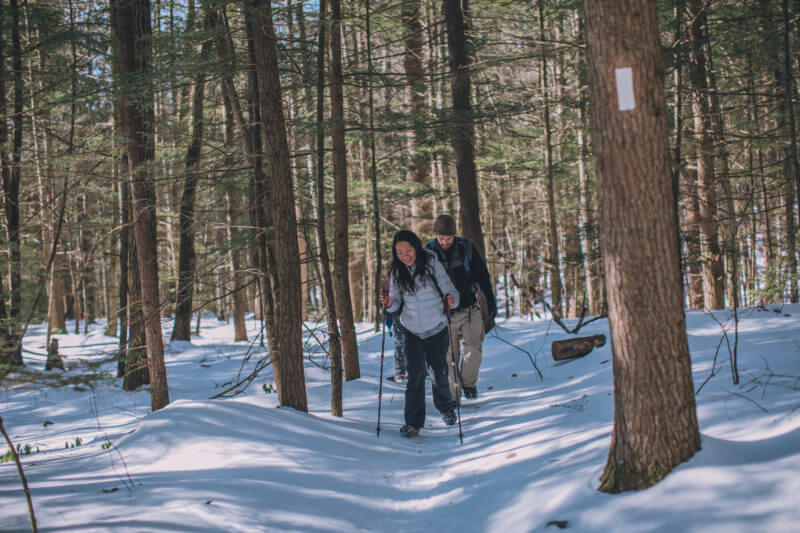
Trekking poles can help provide extra stability and reduce knee impact during winter hikes.
Additional Gear
Backpack: Medium to large size with an adjustable waist belt. You typically carry more gear in the winter that is bulkier and heavier. Make sure your pack can accommodate everything that you need.
Pack cover/liner: External cover to protect your backpack from snow and rain. You can use a plastic compactor bag if your backpack doesn’t come with a cover.
Trekking poles: Poles with handles that provide extra stability and reduced force on your knees while hiking. We recommend using flick-lock style poles with snow bales on the bottom.
Whistle: Helps others locate you in an emergency. A whistle is a more effective way to call for help in the backcountry than your voice. Blow three loud, short blasts to make a distress call.
Headlamp: Light source for hiking on the trail, reading your map, or setting up camp. Make sure to check the batteries before you use a headlamp on a hike and pack a spare set of batteries.
Map/Compass: Navigation tools for tracking your location and the progress of your hike. While GPS units can be useful, you should always carry a map of the area you will be hiking or recreating in and a compass. Remember to leave a copy and itinerary of your route at home or with a friend. Don’t know how to use a map and compass? Check out one of AMC’s outdoor skills courses.
Emergency blanket or bivy: Shelters that will provide protection against the elements in an emergency situation.
Lighter: Fire starter that can help provide warmth or signal for help.
Knife: All-purpose tool for gear repairs, cutting cloth to make bandages, removing splinters, etc.
Lip balm: Prevents your lips for drying out and cracking, which can be painful.
Sunscreen: Protects your skin from UV Rays that reflect off of snow and ice. Bring sunscreen that is at least 20+ SPF.
Hand warmers: Small packets that produce heat and are put inside gloves to warm your hands.
Foam pad: Insulates from the cold of the ground so that you don’t lose body heat when sitting or lying down on the pad. This is great for when you want to take a break during your hike and it will protect you if you are forced to shelter in place.
Dry clothes: Change into these when you have finished your hike and get back to your car. It’s a nice treat for the ride home.
This list was adapted from the AMC Worcester Chapter’s Winter Hiking Gear List and portions of AMC Essential Guide to Winter Recreation.